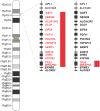What 20 years of research has taught us about the TP53 p.R337H mutation
- PMID: 32875577
- PMCID: PMC7589304
- DOI: 10.1002/cncr.33143
What 20 years of research has taught us about the TP53 p.R337H mutation
Abstract
The p53 tumor suppressor transcriptionally regulates a myriad of genes involved in cell cycle control, DNA repair, cell survival, and cell metabolism and represents one of the most well-studied inhibitors of tumorigenesis. Since the discovery of TP53 in 1979, somatic mutations have been shown to be extremely common; more than 50% of human cancers carry loss-of-function mutations in TP53. Inherited or germline TP53 mutations are rare and are involved in complex hereditary cancer predisposition disorders, and affected family members can develop diverse tumor types and multiple primary cancers at young ages. In Brazil, a fascinating history of p53 and cancer predisposition began in the year 2000 with identification of the TP53 p.R337H mutation in close association with the development of adrenocortical tumors. In these past 20 years, much has been learned about the genetics and biochemistry of this mutation, which is widespread in Brazil because of a founder effect. This review highlights the contributions of TP53 p.R337H research over the last 20 years, the findings of which have sparked passionate debate among researchers worldwide, to understanding cancer predisposition in Brazilian individuals and families.
Keywords: TP53; R337H; cancer predisposition; founder mutation; haplotype.
© 2020 The Authors. Cancer published by Wiley Periodicals LLC on behalf of American Cancer Society.
Conflict of interest statement
Emilia Modolo Pinto and Gerard P. Zambetti report a patent pending (“Genotyping Assays to Identify Mutations in XAF1”).
Figures


References
-
- Marigo C, Muller H, Davies JNP. Survey of cancer in children admitted to a Brazilian charity hospital. J Natl Cancer Inst. 1969;43:1231‐1240. - PubMed
-
- Li FP, Fraumeni JF Jr. Rhabdomyosarcoma in children: epidemiologic study and identification of a familial cancer syndrome. J Natl Cancer Inst. 1969;43:1365‐1373. - PubMed
-
- Li FP, Fraumeni JF Jr. Soft‐tissue sarcomas, breast cancer, and other neoplasms. A familial syndrome? Ann Intern Med. 1969;71:747‐752. - PubMed
-
- Li FP, Fraumeni JF Jr, Mulvihill JJ, et al. A cancer family syndrome in twenty‐four kindreds. Cancer Res. 1988;48:5358‐5362. - PubMed
Publication types
MeSH terms
Substances
Grants and funding
LinkOut - more resources
Full Text Sources
Research Materials
Miscellaneous

